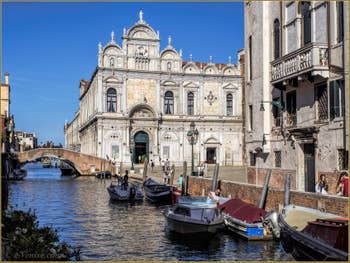History Important dates | Politics | Navy | Love | Wars | Religion | Scuole | Ghetto | Printing
The Scuole Grande and Piccole of Venice

The Scuola Grande San Marco
The Scuole, a Venetian associative and religious system
The Scuole are the headquarters of lay brotherhoods under the patronage of a protective saint.Most of them belonged to the category of Arts and Crafts Associations (the Arti) with a corporate and mutualistic function.
Some provided assistance to a specific social group, such as the Scuola dei Zotti, which was reserved for war invalids, or to foreign groups (Albanians, Dalmatians, Greeks, etc.) who lived and worked in Venice, to facilitate their integration.
The Scuole played an important role in the social cohesion of Venice through the brotherhood that united their members, but also through solidarity and charity towards the weakest and most disadvantaged.
They were responsible for the construction of hospices and hospitals.
The aristocratic Republic of Venice found its perfect illustration in the Scuole, which ensured the rights and well-being of everyone by requiring them to submit to very precise rules of conduct.
A semi-religious, semi-secular status
The Scuole were always located near a church or monastery, or were even attached to them.Their aim was to provide material and spiritual support to their beneficiaries and to promote Christian virtues.
However, the clergy had no control over their administration.
In the Middle Ages, a Scuola was considered large or small depending on its social and economic importance.
They mainly brought together craftsmen, merchants and bourgeoisie, whose interests they defended.
The practice of various trades and the number of people who practised them was controlled and regulated by the Scuole.
Scuole Grandi and Scuole Piccole
Their proliferation coincided with the blossoming of Venetian art between the 15th and 18th centuries.There were nearly 300 of them!
The distinction between Scuole Grandi and Scuole Piccole (major and minor) was made in the 15th century.
There were three types of minor Scuole:
- Those of the guilds of workers, craftsmen and merchants. Each of them had its own Scuola.
- Those of foreign residents.
- Those of devotional brotherhoods whose members were dedicated to the veneration of a saint or the practice of a particular cult.
For example, the Scuola Levantina and the Scuola Italiana are synagogues.
The Scuole Grande belong to the confraternities of Venetian notables: the merchant patricians and the wealthiest bourgeoisie.
They were among the most stable and powerful institutions in Venice.
They were originally created for ostensibly devotional purposes.
They were fraternities inspired by the ascetic movement of the Flagellants, founded in 1260 by Ranieri Fasani, a Dominican hermit from Perugia.
The Scuole San Giovanni Evangelista, San Marco and della Carità date from this period when the churches of the mendicant religious orders appeared.
There are six Scuole Grande: the Scuola San Marco, the Scuola San Teodoro, the Scuola San Giovanni Evangelista, the Scuola della Misericordia, the Scuola Santa Maria della Carità and the Scuola Grande San Rocco.
A distinctive and significant architectural style
From an architectural point of view, the Scuole are rectangular buildings with two large rooms on top of each other, connected by a staircase.The Chapter House was on the upper floor.
The Chapter (Capitolo) was the union of the members of the Scuola.
The buildings of the Scuole Piccole (minor schools) were smaller and less prestigious than those of the Scuole Grandi.
The best preserved Gothic Scuola Piccola is the Scuola dei Calegheri (shoemakers), whose portal is decorated with a bas-relief depicting St. Mark blessing the shoemaker Anian.
In addition to the Chapter Hall, the Scuole Grande had an Albergo, a small room on the main floor where the Banca met: the governing council of the Scuola.
The Banca was a group of 16 members, elected for one year by the entire community, who were responsible for the daily management of the Scuola.
Their income came mainly from membership fees and donations from wealthy patrons, whose generosity was stimulated by the competition between the Scuole grandi to be decorated with the most beautiful works of art.
The Scuole are the museums of Venice
The funds thus obtained were used for charitable purposes, such as helping members in difficulty or the needy, and for purchasing ceremonial objects such as candles and banners.But they were also used to finance expansion and embellishment work by great architects and the best painters and sculptors, whose works enhanced the prestige of the Scuola.
The religious buildings affiliated with the Scuole enjoyed much the same advantages and are as rich in works of art as the Scuole themselves.
No austere brotherhood or charity: Love and Strength had to be fulfilled and revealed through Beauty.
Beauty became an outward sign of virtue, but also of corporate pride and family vanity.
The Political Weight of the Scuole Grandi
« These were small, powerful republics, the scuole, which placed themselves under the protection of a saint.
They erected buildings, decorated churches and spent considerable sums on charitable works.
They distributed more than eighty thousand francs in alms annually, and the five schools of the Battudi each had more than twelve hundred members. »
Molmenti - Private Life in Venice
The Council of Ten exercised ultimate control over the Scuole, but, like the clergy, it had no control over their internal administration.
They were the best means of expression for a certain autonomy enjoyed by wealthy Venetians who were not Patricians.
The Scuole offered compensation to people deprived of the right to vote, thus providing them with indirect means of political intervention.
Citizen members of the Scuole took part in major ceremonies and ducal processions: accompanied by their musicians, they proudly displayed their rules and coats of arms.
History Important dates | Politics | Navy | Love | Wars | Religion | Scuole | Ghetto | Printing
Back to Top of Page

